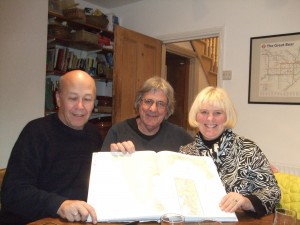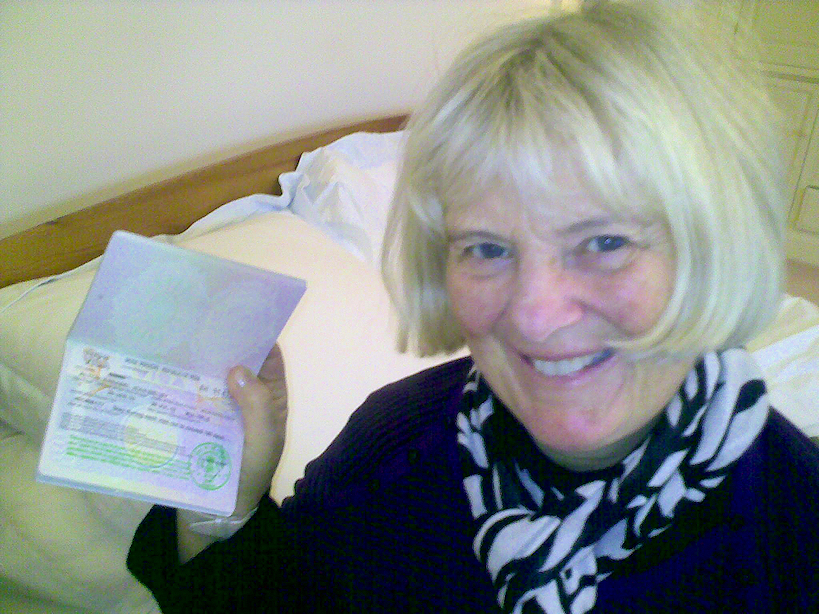Reflections – climate change
Because India normally has a reliable climate (unlike ours in the UK), variations are easier to spot. For us, the fact that we’re going to have snow tomorrow even though it’s late March isn’t necessarily indicative of anything: I remember in the year of the Isle of Wight Rock Festival (?1969?) we had a snow shower in AUGUST! And that was probably well before climate change had reached the scale it has today.
In India, however, these things show up. And they did. We were continuously reminded of changes that have taken place or continue to do so:
- In Ooty we were told that the crows in the botanic gardens were recent arrivals – they have only been arriving over the past 5 years or so. Before that, being 2,600 metres above sea-level, the climate was too cold for them.
- In Munnar the owner of the plantation residence told us that he was having to consider installing air-con in the chalets – they were only built a few years ago, but at the time they perceived no need for it as the weather was always cool.
- In Palakkad the temperature was 39degC and humidity was 98% – unheard of in March (and extremely uncomfortable).
- In Tamil Nadu we were told the monsoon, which normally runs from May to September, continued last year until late November – almost 3 months extra! – which jeopradised one of the rice crops.
- In Kumarakon we had to divert our boat journey because the lake was completely covered in water hyacinth – always a vigorous grower, but recently more so than ever before.
- And Nimmy Paul, in the cookery school in Cochin, told us that when she was a child they had a huge grapefruit tree in her mother’s garden – but now it is quite impossible to grow grapefruit in that region.
Everybody was aware of climate change. There is a significant agricultural element in India’s economy, of course, which makes it more immediate.
The jury might still be out on whether these changes are man-made or not, and whether we can do anything about it. But there was a definite feeling wherever we talked about it that the third world is suffering from past excesses of the developed world, and a resentment that the West is so reluctant to take the steps necessary to ameliorate things.
Just coming over the horizon, of course, is the next big crisis – water. Water shortages are exacerbated by climate change and will hit the poorest in the world first and hardest. This resentment will grow and could become quite poisonous.
Seen from an Indian perspective they really are the low-impact victims of high-impact indulgence. They don’t like it, and I’m sure we wouldn’t either. Added to the pivotal importance of water, there are political clouds on the horizon which could affect us all.
Cochin – final stop
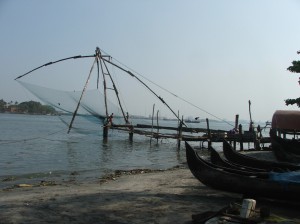 We have reached the final location of our trip. Tomorrow we will fly to Bangalore for the night and then leave for London. We have had several days here, first at the Arches Hotel and then on to the Taj Malabar Hotel for a bit of R&R.
We have reached the final location of our trip. Tomorrow we will fly to Bangalore for the night and then leave for London. We have had several days here, first at the Arches Hotel and then on to the Taj Malabar Hotel for a bit of R&R.
We spent the first day having a look around Cochin. By far the most touristy stop on our trip, but with a rich and varied history. Vasco da Gama was buried here (though later they dug him up and took him back to Portugal). The Dutch and British also took their turns at ruling the place, and there are many signs of these various eras in the city.
There was also at one time a thriving Jewish population, located in the politically-incorrectly named Jew Town. However when Israel was founded in 1948 most of them emigrated there and now there are only four families left. And no rabbi, but a lovely and fascinating little synagogue.
There is much talk of religious tolerance here and certainly as far as we can see there seems to be remarkably little tension between the Hindus, Muslims, Christians (both Catholic and Protestant and many other colours in between) and, presumably, Jews who inhabit the place.
We visited the Chinese fishing nets in the morning, Heath Robinson contraptions that lower a net into the water and then raise it again hoping to catch some fish as they surface. Many of these were damaged by the tsunami.
Bijou showed us round various places including the Parade Ground (once used by the Dutch and then in turn by the British), basilica/cathedral, spice market, bishop’s house and so on. We were introduced to a lot of interesting vegetation – the most intriguing in my view is the Rain Tree, which folds up its leaves in the monsoon rain so rainwater collects in them, and then unfolds them when the rain stops to release a continuation of the rainfall beneath it.
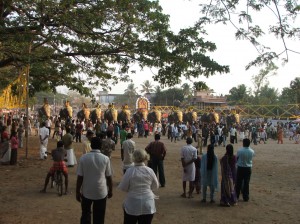 Not an over-picturesque place and so rather limited photo opportunities. But we went for a sunset cruise one day and a farewell dinner outside by the water’s edge the next which were fun. Then we moved hotels to the Taj Malabar.
Not an over-picturesque place and so rather limited photo opportunities. But we went for a sunset cruise one day and a farewell dinner outside by the water’s edge the next which were fun. Then we moved hotels to the Taj Malabar.
That evening, on the recommendation of our driver, we visited a Hindu temple where there was a festival going on with a promised 21 elephants. Too good to be true, of course – there were “only” 13, but pretty impressive nonetheless. Took millions of photos!
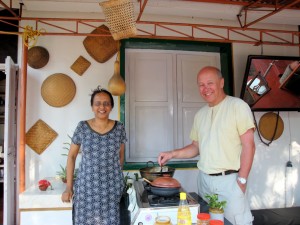 Today was spent by the pool until teatime when we went to a cookery class run by a wonderful woman called Nimmy Paul and her husband Paul (or that might be a wonderful woman called Nimmy and her husband Paul, I’m not entirely sure.) She’s a slightly eccentric lady living in a lovely old house and really knows her stuff – as evidenced by the fact that of all the people involved in the tourism industry that we met, she is the only one who has not had a bad start to the year. Indeed, by the end of February she said she had only had 2 days off in total!
Today was spent by the pool until teatime when we went to a cookery class run by a wonderful woman called Nimmy Paul and her husband Paul (or that might be a wonderful woman called Nimmy and her husband Paul, I’m not entirely sure.) She’s a slightly eccentric lady living in a lovely old house and really knows her stuff – as evidenced by the fact that of all the people involved in the tourism industry that we met, she is the only one who has not had a bad start to the year. Indeed, by the end of February she said she had only had 2 days off in total!
The food was delicious and we left feeling we’d learned a lot and made some new friends.
Although the holiday is over, we will keep this website up for some time and probably add to it over the coming weeks. We have some reflections on our trip, plenty more photographs, and we have been making “collections” of coloured houses, coloured clothes, quirky signs and so on. So come back soon!
By rice boat to Cochin
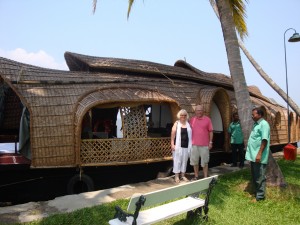 After an abortive sunset cruise last night (the sun vanished behind cloud just as it was about to set) followed by a delicious though extravagant dinner (including a surprisingly convincing Indian sauvignon blanc), we checked out the following morning and boarded our own private rice boat for a 4-hour journey to Alleppi where our trusty driver Anthony was waiting to take us the remaining few kilometres to Cochin.
After an abortive sunset cruise last night (the sun vanished behind cloud just as it was about to set) followed by a delicious though extravagant dinner (including a surprisingly convincing Indian sauvignon blanc), we checked out the following morning and boarded our own private rice boat for a 4-hour journey to Alleppi where our trusty driver Anthony was waiting to take us the remaining few kilometres to Cochin.
We had lunch on board the riceboat and although the weather continues hot and humid the breeze created by our movement gave some relief.
The first half of the journey were simply crossing the lake, but then we entered the backwaters and canals (there are 900Km of canals in Kerala, all man-made or man-improved) and had a wonderful time snapping away happily as people went about their business on the banks.
View gallery
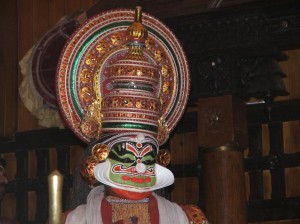
Then arrived at the Arches Hotel in Cochin where thereas a quick turnround to catch a Kathakali performance – traditonal Keralan dance theatre.Then back to the hotel, something to eat in their roofop “restaurant” and a quick exploratory stroll before bed.
Cooking, boats and backwaters
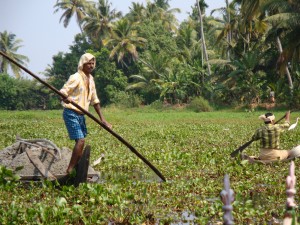
Today we went to have a cookery demonstration. We got there by boat, which took some time because the short route was completely blocked by water hyacinths which apparently clog all the waterways. and are a real pest. Still, we got the opportunity for some great photos of life and colour along the backwaters.
When we finally arrived, in hot and humid weather, they brought us a drink made of ginger juice, lime juice, sugar and water, served chilled, which was quite divine and extremely refreshing. I’ll have to experiment to get the relevant quantities, but it makes an ideal summer drink (if we ever get a summer in the UK, of course!)
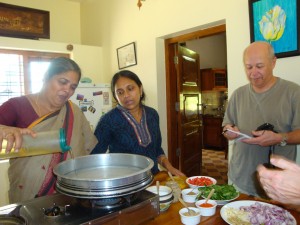 We learned how to cook a super chicken curry, a vegetable curry called Thoran, and dhal (lentils). They also showed us how to make chapatis which I’m really looking forward to doing – it’s very simple.
We learned how to cook a super chicken curry, a vegetable curry called Thoran, and dhal (lentils). They also showed us how to make chapatis which I’m really looking forward to doing – it’s very simple.
So now you know what will be on the menu when we invite you over for an Indian!
Coconut Lagoon
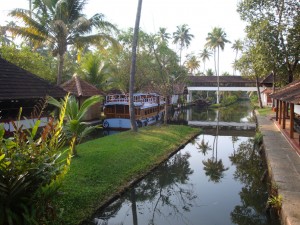
Coconut Lagoon is set on the very edge of Vembanad Lake and, as the name implies, is a mixture of land and water. Inlets run through the grounds and you can only get there by boat, arriving at reception directly off the boat.
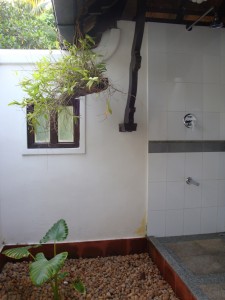
Rooms are individual “cottages” with a bedroom (air-conditioned, thankfully) and an open-air shower/bathroom. This must be spectacular during the monsoon as some of the bathroom is open to the sky and would be streaming with refreshing rain.
The temperature is in the mid 30s Celcius and humidity was 97% when we arrived, making it very uncomfortable and sticky. The coolness of the room was a real treat although it’s strange to get a blast of hot, humid air when you go into the bathroom!
We look forward to tomorrow when we’re going to have our first Keralan cookery demonstration. Went to bed without supper following our spectacular lunch at Anil’s plantation, but after partaking of a couple of gin and tonics in our room from ingredients purchased en route to the hotel (tiffin??)
To Kumarakom
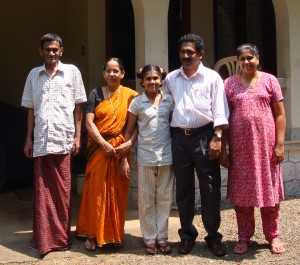 A wonderful day! We set off to Kumarakom which was another 3-4 hour drive. We were invited to Bijou’s home for tea in the morning and met most of his family – father, mother wife and one of his two daughters who had taken the day off school to meet us. It was a great privilege to be invited into his home and see how they live. The family has a small rubber plantation and he explained the process which is fascinating.
A wonderful day! We set off to Kumarakom which was another 3-4 hour drive. We were invited to Bijou’s home for tea in the morning and met most of his family – father, mother wife and one of his two daughters who had taken the day off school to meet us. It was a great privilege to be invited into his home and see how they live. The family has a small rubber plantation and he explained the process which is fascinating.
Then we went on to the house of Anil, a friend of his, which is a pretty traditional family house and has been in the family for seven generations. We had a superb lunch cooked by four of the women of the family and served to us and the men. They had started cooking it the previous day!
The meal started with Mooli, a fish and coconut curry, with (incongruously) a Russian salad. Then there was a barbecued chicken with fried onions and chilli, served with rice, dhal (lentils) and an assortment of salads, plus parotha which is a sort of a cross between a Viennese pastry and a naan. This was followed by fruit – pineapple, watermelon, grapes, papaya and jackfruit which was much nicer than any of us expected.
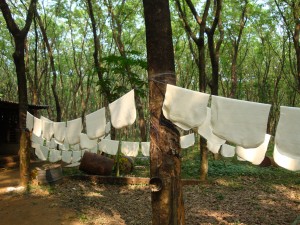 After lunch (by which time it was baking hot again) we were shown another, larger rubber plantation owned by our host. He got one of his workers to demonstrate the tapping process which is fascinating and highly skilled. One man can tap 300 trees in 2 hours, then he goes back to the first ones and collects the latex which has filled the little cups by then. After processing the rubber is hung up to dry in sheets which look a bit like shower mats, which is the form the rubber is sold in. Apparently the top quality rubber is used for aircraft tyres, which I must say I found reassuring.
After lunch (by which time it was baking hot again) we were shown another, larger rubber plantation owned by our host. He got one of his workers to demonstrate the tapping process which is fascinating and highly skilled. One man can tap 300 trees in 2 hours, then he goes back to the first ones and collects the latex which has filled the little cups by then. After processing the rubber is hung up to dry in sheets which look a bit like shower mats, which is the form the rubber is sold in. Apparently the top quality rubber is used for aircraft tyres, which I must say I found reassuring.
We left and went on towards Kumarakom, passing through a town called Kottayam, which is distinguished for being the first town in India to achieve 100% literacy, in 1986. I’m not sure we have any town like that in the UK!
Kerala is ostensibly a Marxist state, so there are hammer & sickle flags all over the place. But I can’t quite see how that works here: all taxes are set by the national government, so they’re the same in every state in India; Kerala has private companies, public companies, property ownership, small businesses and so on which really aren’t the features of Marxism as I know it. Education is good and the roads are (relatively) good, but there doesn’t seem to be a true socialism in existence, nor I feel could there be.
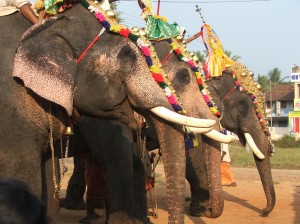 After Kottayam we happened upon a village which was having some sort of Hindu festival. The first sign of this was a crowd of people at a temple and lots of drumming. As we went further, we came upon a bit of ground where there were three elephants standing in a row, all in great finery, and the villagers were making offerings of rice. After a bit the drums struck up and the elephants set off on a procession, presumably to the temple we’d seen earlier. A fantastic sight and a real bonus for the day.
After Kottayam we happened upon a village which was having some sort of Hindu festival. The first sign of this was a crowd of people at a temple and lots of drumming. As we went further, we came upon a bit of ground where there were three elephants standing in a row, all in great finery, and the villagers were making offerings of rice. After a bit the drums struck up and the elephants set off on a procession, presumably to the temple we’d seen earlier. A fantastic sight and a real bonus for the day.
At Kumarakom we got onto a lovely old steamer-type boat and travelled to the Coconut Lagoon which is a wonderful luxury resort hotel where we will be relaxing for a couple of days after the rigours of our travels. This is where the trip starts being a bit of a pamper!
Munnar
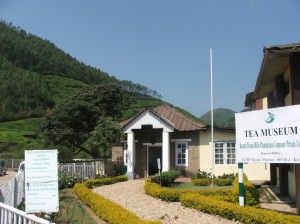 To our relief, the next day we started uphill again, to Munnar which is a tea town up in the hills. Less high than Ooty at a “mere” 1,000 metres, it was still pretty hot. The hills were quite misty, but strangely for us Brits it was still hot, so the effect of the mist was to make it more humid and hence subjectively even hotter.
To our relief, the next day we started uphill again, to Munnar which is a tea town up in the hills. Less high than Ooty at a “mere” 1,000 metres, it was still pretty hot. The hills were quite misty, but strangely for us Brits it was still hot, so the effect of the mist was to make it more humid and hence subjectively even hotter.
Munnar is famous for tea and spices. It is the location of the so-called High Range which was one of the most successful tea-growing areas in India set up by the British. It is still a thriving concern, though ownership passed from the British to the Tata family companies and then more recently it has become a worker’s co-operative.
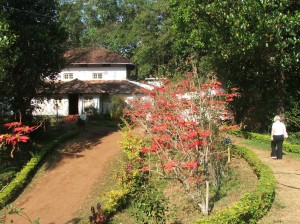 We stayed on a plantation owned by a doctor who used to practise in Bangalore but has now taken over the house and grounds (some 70 hectares) on behalf of the family. They grow mainly cardamom, but we went on a nature walk and also saw pepper, coffee, jack fruit and a variety of other crops.
We stayed on a plantation owned by a doctor who used to practise in Bangalore but has now taken over the house and grounds (some 70 hectares) on behalf of the family. They grow mainly cardamom, but we went on a nature walk and also saw pepper, coffee, jack fruit and a variety of other crops.
We had two nights in Munnar. During the day we visited a tea plantation, went round the colourful local market and did some shopping for spices. Our guide, Bijou, was getting more enthusiastic now we had entered his home state and was good at explaining about tea growing, pointing out interesting plants and animals (we saw a giant squirrel and some cashew nuts on a tree) and explaining about the geography of the area.
Tiffin
Since getting into Tamil Nadu a few days ago, and continuing now we’re in Kerala, we’ve been seeing a number of café/restaurant places saying things like “Tiffin served here” – which gave rise to the question – what exactly is tiffin?
Our guide is emphatic that it means breakfast. However this doesn’t chime with our own feelings about how we’ve heard it used – to mean afternoon refreshment of some kind, either at teatime or something more alcoholic.
Annabel asked our host at the homestay in Palakkad, a very educated gentleman who went to the best school in Tamil Nadu and then to Berkeley University in San Francisco; and he said it can mean any snack.
There is also an object called a tiffin, which is a cylindrical tin canteen used by workers in Northern Indian cities to take their lunch to work. And I think I have heard of people in Mumbai who will collect empty tiffins from office workers in the morning and return them, filled, in time for lunch.
Wikipedia says the word means “Lunch or any light meal,” and continues: “It originated in British India, and is today found primarily in Indian English. The word originated when Indian custom superseded the British practice of an afternoon dinner, leading to a new word for the afternoon meal. It is derived from the obsolete English slang tiffing, for “taking a little drink or sip”. So maybe we’re all right. Read entire entry: http://en.wikipedia.org/wiki/Tiffin
Nonetheless I reckon it could make an interesting Radio 4 programme: “In search of Tiffin”. Bring on (Sir) Mark Tulley!
Then there’s Toddy…
Palakkad
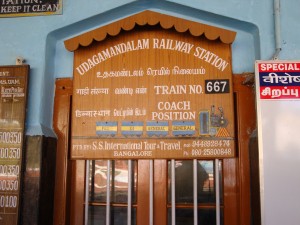 In the morning we repaired to Ooty station where we took a train to the little town of Coonoor, where Anthony our driver picked us up and drove us on to Palakkad – another long drive, this time downhill.
In the morning we repaired to Ooty station where we took a train to the little town of Coonoor, where Anthony our driver picked us up and drove us on to Palakkad – another long drive, this time downhill.
The railway was fun and had a lot of very typical Indian signage which we photographed avidly. There was a section that had been washed away in the previous monsoon, and which the train went over at a snail’s pace with much whistle-blowing and creaking and groaning. From the window we got our first glimpse of a tea plantation – more later.
We entered Kerala, the third and final state of the trip, and arrived at Palakkad.
Palakkad was HOT! It was one of the hottest places in India that day, and touched 39°C. And very humid, so it was pretty unpleasant.
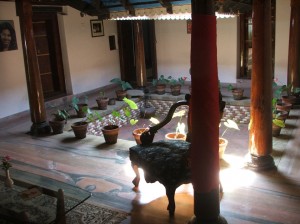 We stayed at a traditional house run by a man in whose family it had been for several generations. The owner is called Bhagawaldas Kandath, rather unbecomingly abbreviated to Bhag, pronounced “Bug”.
We stayed at a traditional house run by a man in whose family it had been for several generations. The owner is called Bhagawaldas Kandath, rather unbecomingly abbreviated to Bhag, pronounced “Bug”.
It was an interesting and unusual experience, though uncomfortable because of the heat and lack of functioning air conditioning. We were shown some village pottery being made and walked around the village talking to the locals. Annabel had a long chat with two girls, their mother and grandmother, who obviously wanted to practice their English and asked Annabel what her “good name “ was. They were intrigued by her blonde hair and blue eyes.
The house was basic, even primitive, but with some nice original features and a traditional layout which included a courtyard-style living room with an open roof in the middle which becomes a waterfall during the monsoon!
Ooty
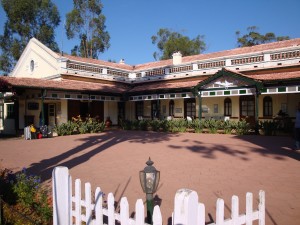 From Nagarhole we embarked upon a 4-hour drive to Ooty, a hill station town built by the British in the 19th century. It is 2,600 metres above sea level (by contrast Ben Nevis, the highest mountain in the UK, is about 1,250 metres high.)
From Nagarhole we embarked upon a 4-hour drive to Ooty, a hill station town built by the British in the 19th century. It is 2,600 metres above sea level (by contrast Ben Nevis, the highest mountain in the UK, is about 1,250 metres high.)
Ooty is our only stop in Tamil Nadu, the second of three states we are visiting this trip. They say that the inhabitants of Tamil Nadu have three abiding passions: temples/religion (there are over 2,000 Hindu temples in the state), politics and movies. We certainly saw plenty of temples.
We drove for some time over the plains, through two more national parks, and then began our ascent – a chaotic road with 36 hairpin bends and lots of unpredictable Indian traffic!
We arrived at the Savoy Hotel in Ooty in time for a late lunch (though for a variety of reasons this didn’t actually happen.)
The Savoy is a fascinating relic of the Raj – British suburban architecture from the 19th Century, and sparse with no central heating (a “wallah” comes round and asks if you want a fire lit in your room) or air conditioning, and the sort of interior appointments that reminded me of aged aunts’ houses in the ’60s.
After the lunch that wasn’t we went round the town – it was beautifully fresh and cool. Because it was a Sunday there were hoards of people about, families enjoying the weather and visiting the Botanic Gardens, which we also walked round.
An intriguing little place, iconic of the strangeness that is post-Raj India – Hinduism, Islam and Christianity (both Catholic – Portuguese – and Anglican) all co-existing peaceably, strange throwbacks like houses and churches designed by British architects and looking somehow like the heart of the Home Counties, yet all around Indian culture (insofar as that can be thought of as an entity) and a great feeling of “Indian-ness.” Ooty is a tea-growing centre and also a big centre for education, with the best secondary school in India nearby at Lovedale.
Nagarhole National Park
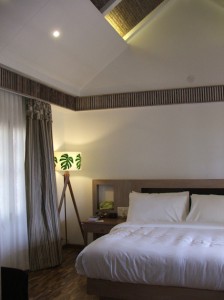
The hotel was a delight after the noise and smells of Bangalore and Mysore, and it was wonderful to relax in peace after a bumpy 3 1/2- hour drive over bad roads.
But no relaxing! Many animals come to the water at the end of the day to drink, especially in the dry season, so we set off on a boat safari to see what we could see. We weren’t disappointed!
Up early the next day for a Jeep safari deep into the jungle, and then a spot of birdwatching before another Jeep safari in the evening.
I will post photos when I can next get online – probably Tuesday or Wednesday.
We are now in Ooty, some 2,000 metres above sea level in the Western Ghats. A lovely, cool, clean place built by the British. As it’s Sunday there are lots of people out enjoying the day and walking around the Botanic Garden.
Tomorrow, a train ride and 5-hour drive to Palakkad – I must get some sleep now!
Mysore to Nagarhole National Park
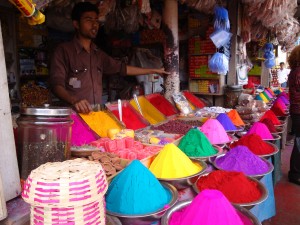
Before we left Mysore in the morning we visited the market. Annabel got her colour fix from the superb fruit, vegetables, flowers and dyestuffs that were all over the place. It was remarkably clean and well-kept and the produce looked in prime condition.
Then we piled into the bus for the 3 1/2-hour drive to Nagarhole (pron. Na-gar-hol-y) National Park for a stay of 2 nights.
Mysore
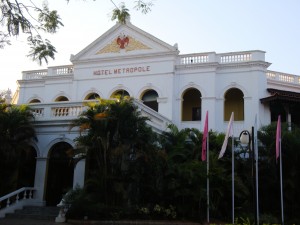
Apologies for the break in despatches – we moved to Mysore on Wed. 17th and that was a bit hectic, followed by connectivity problems in the hotel in Mysore until today (Thur 18th.) These are likely to get worse rather than better over the next few days – I doubt if the Cicada Kabini in the Nagarhole National Park will have internet access, so it may have to wait until Sunday before I can post again. So please bear with us!
On Mon 15th evening met up with guide and 2 other travellers for briefing ready for the tour proper. They were knackered, having got in at 11am (5:30am London time) after travelling for 24 hours via Abu Dhabi.
Tues morning was an early start, quick visit to the Gardens again and then a Bull Temple before heading off to Mysore – a 3 1/2 hour drive, stopping for lunch on the way (lovely South Indian Special – lots of different dishes on a great big plate.)
Our hotel here is great – have a look at their website. Faded grandeur and some things actually work quite well (not internet acces, however!)
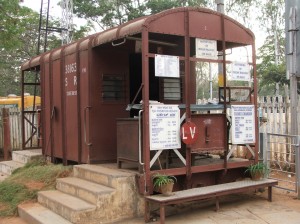
You’ll have to refer to the Itinerary for our visits in Mysore – it’s been a bit hectic again. But Annabel negotiated an additional visit to the Mysore Railway Museum for the train buffs in our audience - about six or eight old steam engines, all made in England, next to the railway station (a bit like a miniscule York Railway Museum, but hot, dusty and ramshackle – actually, not at all like York Railway Museum!)
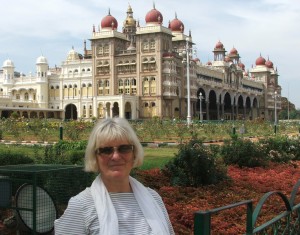
The most dramatic place we visited was Mysore Palace - also built by a maharaja but infinitely grander than Bangalore’s “Windsor Castle” one. Unfortunately photography is not allowed inside, but you can get a taste on their website (go to Unique Rooms.) In the Wedding Hall, the pillars are single-piece hollow cast iron made in Glasgow, of all places! Oh, the Raj…!
Bangalore Palace
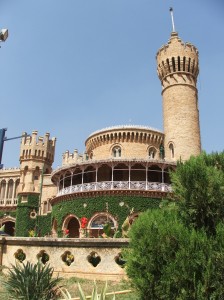
Up quite early this morning and through the Bangalore rush-hour by Rickshaw to Bangalore Palace, built in the 19th Century for the Maharaja/King of Bangalore by an English architect and allegedly inspired by Windsor Castle.
On the way we had the opportunity to photograph some fascinating and rather surreal wall-paintings on the walls of an underpass.
The Palace is still occupied by the last Maharaja (“last” because he has no children, and looking at the wall-painting of him I think I know why!)
The Wodeyar dynasty of Maharajas lasted from the 14th century to 1947 – the Maharajic system came to an end with the British Empire, though they kept their assets and are still considered royalty by many.
The Wodeyars also had extensive property in Mysore, where we are going tomorrow, and a collection of vintage cars, Rolls-Royces and the like, which they apparently sold last year, putting all the guidebooks out of date but no doubt helping the bank balance somewhat.
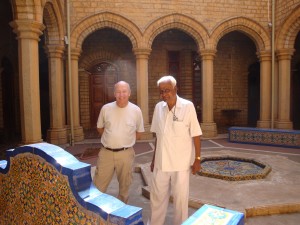
We were shown round by Babu, an old retainer of 70 who could still remember the grand old days of big game hunting, huge processions of elephants, soldiers and royalty which pretty much came to an end in the late 1940s.
Lalbagh Gardens, Bangalore
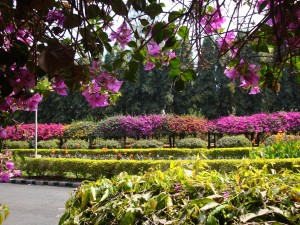 Visited Labagh Gardens this morning. Hard work getting in – everybody wants to get into your pocket (or wallet, more like) and our Rickshaw driver seems to have a different programme for us than what we want to do!
Visited Labagh Gardens this morning. Hard work getting in – everybody wants to get into your pocket (or wallet, more like) and our Rickshaw driver seems to have a different programme for us than what we want to do!
However after a tussle over the cost (they wanted 1,000 rupees, we paid 100) we got a ride on buggy which took us round the gardens and it was great fun. A bit bizarre in places – a glasshouse inspired by Crystal Palace, topiary garden, giant model chimpanzees holding signs to the headquarters of the Horticultural Directorate and models of the 7 dwarves surrounding a floral clock sponsored by an engineering firm. All part of the rich tapestry!
Yum Yum…
The next time you visit Bangalore we seriously recommend the SouthIndies Restaurant. A veggie restaurant on the 4th Floor of the Chevron Hotel in Infantry Road, the food is superb and amazingly good value.
I had a mulligatawny soup to die for, then we had a selection of South Indian dishes including ingredients such as mango, coconut, ginger, chilli, coriander etc. A wonderful meal!
Arrived in Bangalore
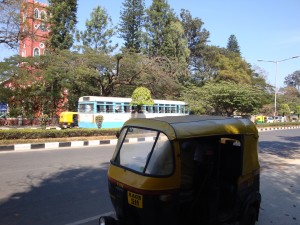 Flight arrived 5:00am local time, 11:30pm UK time. Got to hotel and slept until 1.30! Jetlag…
Flight arrived 5:00am local time, 11:30pm UK time. Got to hotel and slept until 1.30! Jetlag…
A quick 1hr trip around the Hotel area in an auto rickshaw, then slumped in room again.
Happy to be here! View gallery
Updates
An update on the website – now protected by username and password at Annabel’s request. New Twitter account created (approved followers only) to keep these tweets away from my normal business ones.
Travel pack has arrived
This morning’s post included the travel pack from Travel Indochina (plus document wallet and labels.) Makes you feel as though you will be going after all.
Toby has his visa already, Annabel’s is being processed at the moment – always a niggling worry until you actually get your passport back.
Medication: both of us have had the requisite jabs, Annabel has her malaria pills - Toby is going to get his on Monday together with industrial quantities of Loperamide (Lomotil) just in case!
Decided to set up this blog, mainly for photos but also to record the trip if we have the time, facilities and inclination to do so.
Have just added a Twitter feed here as well so we can use that if all else fails.
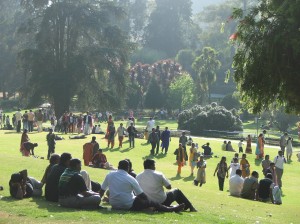
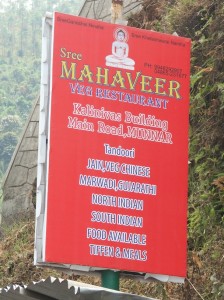
![DSCF5584[1]](http://www.acardfromme.com/wanda/wp-content/uploads/2010/02/DSCF55841-300x225.jpg)
